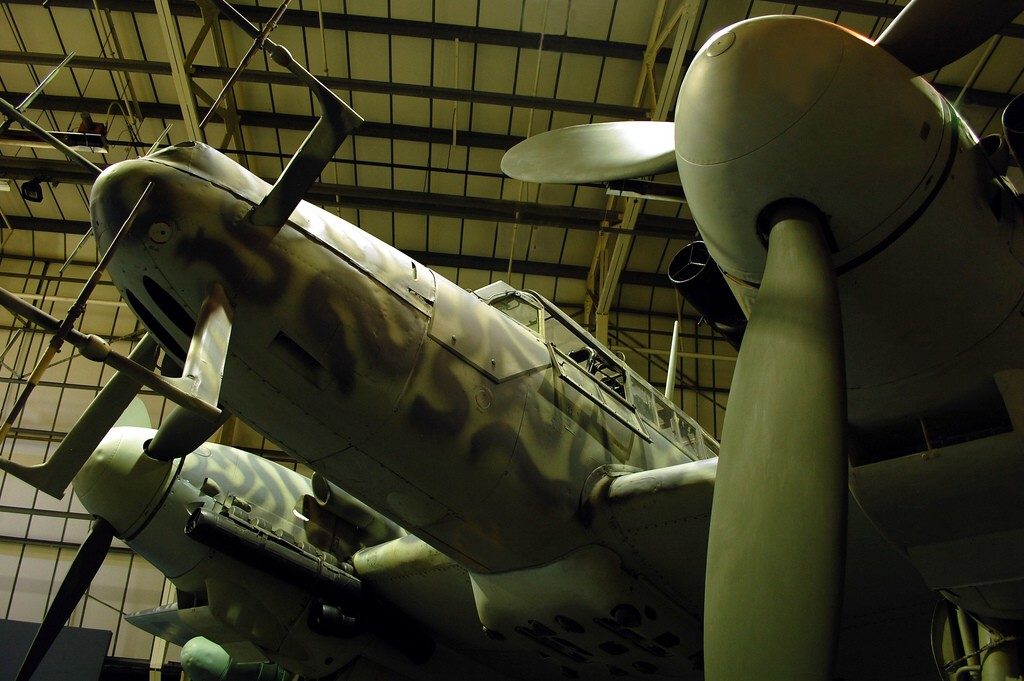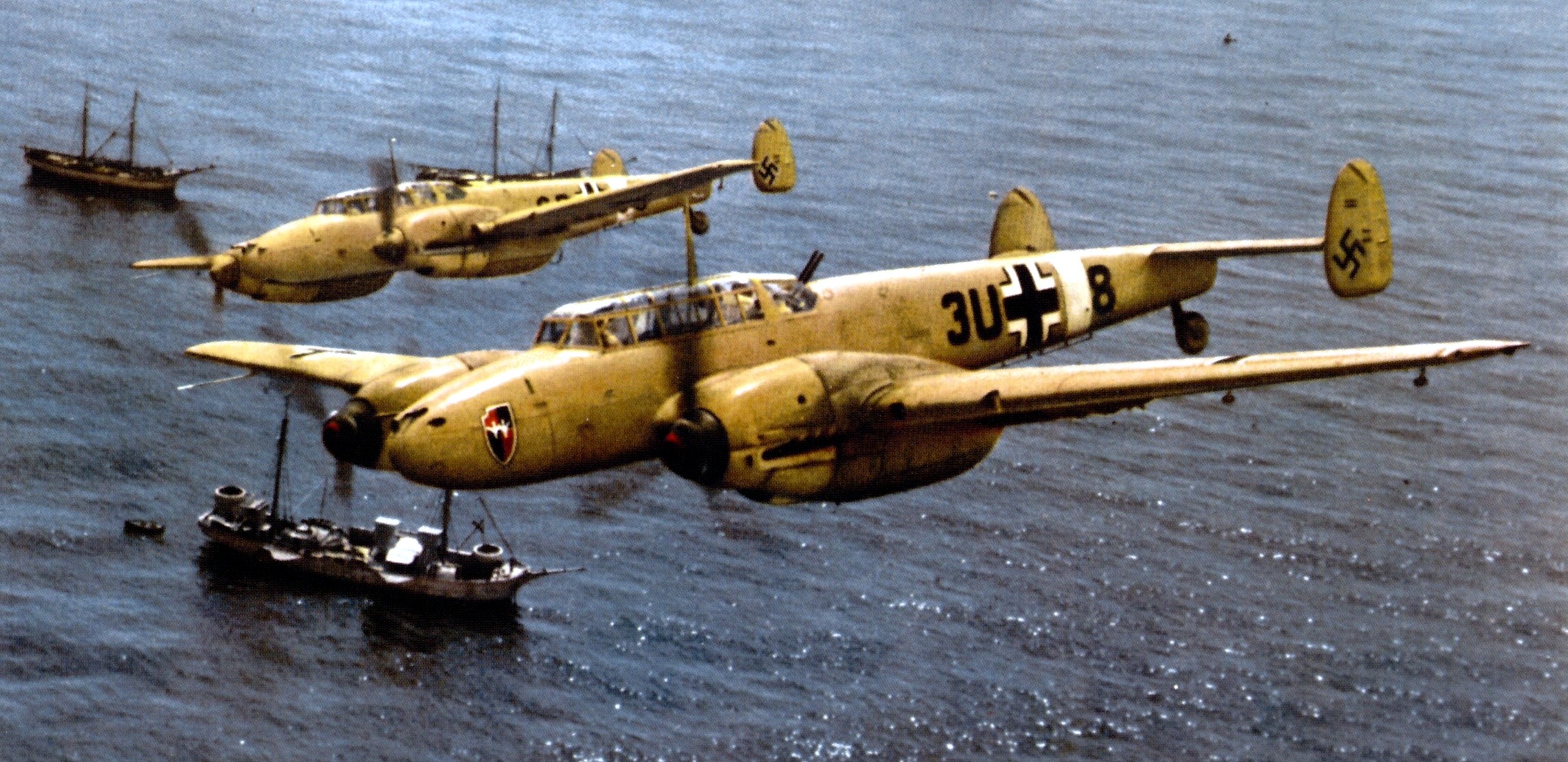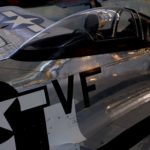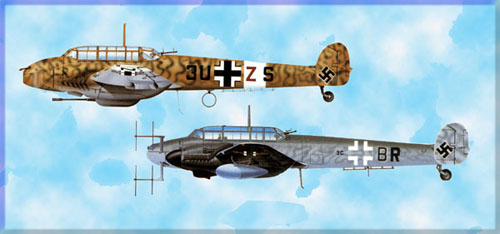Messerschmitt Bf110 730301
‹ Return to Aviation History

Messerschmitt Bf110 730301
On display at the RAF Museum in London. Not easy to photograph – dificult to get the entire aircraft in the frame and I have tried to edit out some lens flare from the lights above.
The twin engined Messerschmitt Bf110 was designed as a heavy fighter but was out maneuvered by Spitfires and Hurricanes during the Battle of Britain, and they were shot down in huge numbers.
However the Bf110 excelled as a night fighter – the aircraft here is an example of such, with its complicated array of radar antenna. Fitted with a cannon which slanted upwards from the back of the cockpit (and nick named Schräge Musik, or Jazz Music), Bf110 pilots would fly unseen beneath the belly of a fully laden RAF bomber and fire the cannon directly into the bomb bay. The resulting explosion would often take out the attacking plane as well. *see edit below
RAF bomber crews reported back at debriefing sessions that they had seen what looked like entire bombers just exploding in mid-air. The received wisdom (and whether this was deliberate misinformation or not is unknown) was that the Germans had developed a type of ground to air shell which when detonated, looked exactly like a heavy bomber exploding. RAF crews referred to these shells as Scarecrows. But of course, there were no such things as Scarecrow shells. What looked like a bomber suddenly disappearing in a ball of flame was in fact just that.
One of my favourite aviation photos, a pair of Messerschmitt Bf110s, earlier models to the one above. The uniform sand coloured camouflage for the African campaign, and the markings on the aircraft mean they can be identified and placed. They are of the group ZG 26 “Horst Wessel” and this photo was probably taken over the Mediterranean in 1941.

*Edit 07 January 2024
Please see comment below by EmmCee who adds,
Have to perhaps make a couple of corrections on the description of tactics Bf110 pilots used when employing the “Schrage Musik” against enemy bombers.
It was very quickly realized that shooting at the bomb bay would often result in destruction of the bomber but often catastrophic damage to the attacking aircraft. Most pilots would approach to within 100-150 mtrs and fire at the fuel cells located just inboard of the innermost engines on a four-engine bomber or at the wing root of a twin engine type, only a few rounds usually meant the end of the prey.
Also, whilst some Bf110 units suffered heavy losses during the Battle of Britain, overall the 110 units did quite well, especially when permitted to operate on “freijagd” or free chase sorties as indicated by the not insubstantial number of 110 pilots that achieved “ace” status over the period. Probably the most successful being Hans Joechim Jabs of ZG76 who scored 18 victories during the Battle of Britain, all flying the Bf110. Jabs was very good at employing “Boom-and-Zoom” tactics against RAF single seaters, on one sortie he destroyed three Spitfires in a single action.
24 comments on “Messerschmitt Bf110 730301”
Leave a Reply to mick cooke Cancel reply
Image Information
-
Full Size: 1024×681px



great shot Ian in the museum gives it some atmosphere interesting
story to go with it
Bel punto di ripresa… mi piace. Bravo!!
strewth,ian…bloody great effort,mate…bout the best i,ve seen this,yet…
What a plane.Remember sticking together airfix models as a kid of these.
Great info Ian and a spectacular shot . Done well to cram it all in the frame like that . Definately see what it looks like despite the cramped conditions inside the museum.
The first German nightfighter unit began operations in July 1940 ,it being called Nachtjagdgeschwader 1, they didnt use radar like this aircraft but flew around a zone marked by searchlights until one picked up an Allied bomber and then attempted to shoot it down .
The first success was on the 9th July when Whitley N1496 fell to this tactic . Fortunately the crew survived to become POWs.
Excellent capture, very interesting history story to go with it. Good job.
Ended up as a nice shot Ian – the angle works here.
I’ve only managed to get some shots from the displays at Yeovilton so far.
Nice shot Ian.
Very nice! Filled the entire image!
Any info on this particular airplane? When & where it was captured? The paint job doesn’t seem right for a night fighter, looks to me more like desert camouflage.
Thanks for the nice comments people. Not an easy museum to photograph in, darkly lit and lots of lens flare; should’ve taken a proper tripod, had only a gorillapod so my angles were limited…. There was a Battle of France veteran Hurricane, the prop of which would’ve been ideal to hang the camera from, but I wouldn’t have had time for a 1 second exposure before being kicked out.
Lessons learnt.
It’s probably the hue on the image makes it look like desert camo. Image showing desert and night camo, which is from the site linked below (and there’s also a better photo of this plane on there from someone who took a proper tripod with them)

http://www.sepsy.de/lf-mebf110g-4nightfighter.htm
(Note the Bf110 in desert camo is of the same Group as the pair in the photo over the Med)
As you probably know, Luftwaffe camo didn’t strictly follow any precise rules (unlike RAF), but I agree, the mottling effect on the Bf110 in my photo does look like a desert camoflage pattern!
As for the history of 730301, this is from the muesum;
"May 45 Surrendered to the allies at Grove airfield, Denmark (now known as Karup). Coded D5 + RL. The aircraft had latterly served with 1/NJG3 in the night defence of Denmark and Northern Germany.This particular aircraft is fitted with FuG220b Liechtenstein SN-2 radar – the G-series being specially developed as night fighters. (i.e. 1st Staffel (Squadron) of Nachtjagdgeschwader 3)."
It was repainted twice, once in 1960, then in 1976;
"At this time (1960) the aircraft carried two-tone mottled blue-grey top surfaces, light blue undersurfaces, and the black fuselage codes `OL’.1976 Restored by volunteers at St.Athan; stripped to bare metal and repainted in blue/grey scheme with original codes D5 + RL."
Cracking shot that Ian. Love the info.
I think you’ve taken a better picture by just getting the front of the craft. it looks really impressive.
Brilliant Ian , its a bottomless pit , the more you dig the more you find , what a cracking hobby this is .
Great shot mate, you did well with the compo.
Looks really menacing from that angle too.
Why would you have been kicked out for taking pics?
[http://www.flickr.com/photos/highy/]
No they were very friendly, but if I had used a Hawker Hurricane as something to position my camera on to take a photo, I would’ve been told off I’m sure!
Ah!
Bloody good tripod though ; )
Excellent shot of the business end of a ME110, you have done brilliantly. As a kid I took a mad flap trying to get the antenna A) to stick in the holes in the nose of the aircraft B) to stay straight till they had set and not droop C) not break them off while painting them…happy days.
Brilliant shot, especially considering that the RAF Museum does not easily lend itself to photography.
This a fabulous image Ian…. considering no tripod…. brillant and lovely post shoot edit
[ via Ian D B’s flickriver —Richard Tierney ]
Nice shot Ian! If I remember correctly the British then developed a receiver to warn the bomber crew they were being illuminated by a night fighter and this reduced losses, The Germans then developed a receiver to pick up the threat warning receivers mounted on the bombers! War advances science and technology at a great rate!
[http://www.flickr.com/photos/bill_fawcett]
Thanks Bill. Yeah you’re not kidding. The war started with biplanes and ended 6 years later with jet fighters! I didn’t know that about the detection and warning systems.
Have to perhaps make a couple of corrections on the description of tactics Bf110 pilots used when employing the “Schrage Musik” against enemy bombers.
It was very quickly realized that shooting at the bomb bay would often result in destruction of the bomber but often catastrophic damage to the attacking aircraft. Most pilots would approach to within 100-150 mtrs and fire at the fuel cells located just inboard of the innermost engines on a four-engine bomber or at the wing root of a twin engine type, only a few rounds usually meant the end of the prey.
Also, whilst some Bf110 units suffered heavy losses during the Battle of Britain, overall the 110 units did quite well, especially when permitted to operate on “freijagd” or free chase sorties as indicated by the not insubstantial number of 110 pilots that achieved “ace” status over the period. Probably the most successful being Hans Joechim Jabs of ZG76 who scored 18 victories during the Battle of Britain, all flying the Bf110. Jabs was very good at employing “Boom-and-Zoom” tactics against RAF single seaters, on one sortie he destroyed three Spitfires in a single action.
Hi, thank you for that additional information, it’s very interesting and good of you to provide it. I have copied it to the main narrative above because details like this can get overlooked in comments sections.
Thanks again,
Ian